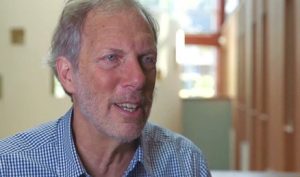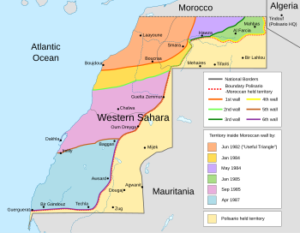
Robert Pollin ~ Photo: UMass Amherst
06-27-2024 ~ Progressive economist Robert Pollin weighs in on “Bidenomics” and the economic policies of Trump’s administration.
The economy is a top issue for many voters ahead of the 2024 presidential election. In a lengthy interview ahead of the first presidential debate between Joe Biden and Donald Trump, world-renowned progressive economist Robert Pollin offers a detailed and thorough assessment of the actual state of the U.S. economy and the effects of Biden’s economic policies. Pollin is a distinguished university professor of economics and co-director of the Political Economy Research Institute (PERI) at the University of Massachusetts Amherst. His books include The Living Wage: Building a Fair Economy; Contours of Descent: U.S. Economic Fractures and the Landscape of Global Austerity; and Back to Full Employment. He has been a consultant to, among other organizations, National Nurses United, the American Postal Workers Union, the Washington State Labor Council, Labor Network for Sustainability and the BlueGreen Alliance.
C. J. Polychroniou: The economy will be one of the key issues in the 2024 U.S. election and may very well determine whether it will be Joe Biden who will be reelected as president or whether we will see Donald Trump return to the White House. As one would reasonably expect, of course, the two primary candidates for the 2024 presidential election have radically different takes on the state of the U.S. economy. Biden recently told NBC’s “TODAY” that “America has the best economy in the world,” while Trump claims that the economy is collapsing. Let’s start by talking about “Bidenomics,” the nickname for Biden’s economics policies and plans. Is Bidenomics a real economic philosophy? If so, what does it encompass?
Robert Pollin: Bidenomics does certainly encompass an overarching framework for dealing with many of the most basic economic problems under U.S. capitalism today, while still, obviously, operating well within the boundaries of the existing capitalist social order.
The starting point for Biden’s economic program is the aggressively pro-Big Business, pro-Wall Street and pro-rich neoliberal variant of capitalism that has dominated U.S. policy making for the past 45 years, under both Democratic as well as Republican administrations. Biden has been pushing out of this neoliberal straightjacket through initiatives that support working people, unions, a viable climate stabilization project and public sector-led economic development initiatives more generally. Of course, Biden himself has never been a leftist of any variety. He is a rather career politician and centrist Democrat. But he has allowed his administration to be moved leftward by the Bernie Sanders and Elizabeth Warren presidential campaigns and allied progressive labor unions and social movements throughout the country. These union and progressive groups deserve major credit for this accomplishment.
More specifically, what does it mean that Biden has been pushing out of the neoliberal straightjacket?
We can begin with Biden’s first major economic policy initiative. This was the March 2021 American Rescue Plan. Its purpose was to prevent the onset of a full-scale economic collapse on the order of the 1930s Great Depression in the face of the global COVID lockdown. The Biden rescue plan entailed a massive injection of government spending, at $1.9 trillion (or about 9 percent of overall U.S. economic activity, i.e. GDP) at that time. This boosted overall spending in the economy, which, in turn, counteracted the sharp rise in unemployment and spending cuts by both households and businesses that resulted from the COVID lockdown.
It is true that two previous stimulus measures to counteract the COVID lockdown were enacted while Trump was still in office, in March and again in December 2020. (The December 2020 measure was passed after Trump had lost the 2020 election.) In combination, these two initiatives under Trump were actually larger than the Biden stimulus. But the composition of government stimulus spending was much more egalitarian under Biden. Biden’s American Rescue Plan focused on direct stimulus checks to households, providing funds for state and local governments to sustain their public health, education and public safety programs, the expansion of unemployment benefits, the protection of workers’ pension plans, and expanding the tax credit program for low-income families with children. By contrast, the stimulus measures under Trump were heavily skewed to supporting businesses. Big corporations and Wall Street firms were at the front of Trump’s handout line.
The Biden rescue plan, in combination with the prior Trump measures, did indeed prevent a 1930s-level economic collapse in 2021. Unemployment in the U.S. could well have risen to perhaps 15-20 percent in 2021. Who knows how severely the global economy could have unraveled from there? But this achievement by the Biden administration has gone mostly uncredited, given that it succeeded in preventing a calamity that did not happen, as opposed to advancing a positive economic breakthrough of some sort.
In terms of positive initiatives, for starters, the Biden administration has been, overall, more supportive of U.S. workers and the union movement than any U.S. administration since the New Deal under Franklin D. Roosevelt. This represents a 180-degree reversal from the Trump years. As one highly visible example, Biden himself was on the picket line in 2023 supporting the highly successful United Auto Workers (UAW) strike against Ford, GM and Chrysler/Stellantis. Biden has also vocally supported organizing efforts at, among other places, Starbucks, Tesla, Toyota and Amazon. More broadly, the U.S. Labor Department, National Labor Relations Board (NLRB) and even the Federal Trade Commission under Biden have also been strongly pro-worker on critical health and safety issues and employees’ rights at the workplace.
At the same time, Biden has not been fully consistent in supporting labor. Most notably, in 2022, he imposed a settlement to prevent a strike by U.S. railroad workers. This meant that the new union contract did not provide any paid sick leave for the workers, something many union leaders thought they could have won had Biden stayed with them. The power of capital prevailed in this case. Still more organizing is the only answer.
Relative to his Democratic and Republican predecessors during the neoliberal era, the Biden administration has also been active in advancing anti-monopoly policies, including lawsuits and other initiatives against Apple and Google, and through blocking mergers between Spirit and JetBlue Airlines, and between Kroger and Albertsons supermarket chains. These measures to counter giant corporations’ market power also feeds into the Biden administration’s efforts to control inflation. What has become clear over the past three years is that one major driver of overall price increases — i.e. inflation — has been what is now termed “greedflation.” Greedflation refers to giant corporations marking up prices and fattening profits. They get away with this because they dominate their respective markets. Antitrust policies are supposed to restrain such corporate greed. But prior to Biden, the enforcement of antitrust policies had been feeble for decades. More on this below.
Biden has also proposed significant tax increases on U.S. corporations and the rich, even while, unfortunately, these proposals have zero chance of passing in the Republican-controlled House of Representatives. These measures could go far to financing, for example, an extension of the Child Tax Credit program that was enacted as part of the March 2021 COVID lockdown stimulus bill. Before it expired, this short-term measure cut child poverty roughly in half in 2021, from roughly 10 percent to 5 percent of all children. It could continue to significantly improve living conditions for the poor and near-poor in the U.S. if it were renewed, as Biden has proposed. By contrast with the fate of Biden’s progressive tax proposals, the huge tax cuts for and the rich that Trump proposed soon after he took office in 2017 did indeed become law within months. Trump has promised more of the same if he gets reelected. Big capital and billionaires are openly salivating at the prospect.
Both the climate-focused and broader public investment-led features of Biden’s agenda are best represented by three initiatives that Biden did manage to get enacted into law in 2022-2023: the Inflation Reduction Act (IRA), Bipartisan Infrastructure Law (BIL) and the CHIPS and Science Act. These are measures to advance a green energy transition, infrastructure and semiconductor manufacturing in the U.S. In combination, these programs are designed to support about $300 billion per year (about 1.2 percent of current GDP) in new investments, with clean energy investments amounting to about $100 billion per year, or one-third of total investment spending coming from these measures. At this level of new investment spending, these programs would generate around 3 million jobs per year, equal to about 1.8 percent of the current overall U.S. workforce.
Despite its name, the IRA was never actually focused on inflation control. Rather, it is the most ambitious climate stabilization program ever enacted in the U.S. The origins of the IRA trace back directly to the work of committed and effective Green New Deal activists throughout the U.S., such as those in the Sunrise Movement, 350.org, the Working Families Party, the Labor Network for Sustainability and the BlueGreen Alliance. Their organizing efforts were then embraced by members of Congress, including (among others) Representatives Alexandria Ocasio-Cortez and Pramila Jayapal, and Senators Edward Markey and Bernie Sanders. The version that Biden got enacted was far less ambitious than what had come out of the Green New Deal movement, and is, by itself, not close to adequate for achieving a zero CO2 emissions global economy by 2050 that is needed to stabilize the global average temperature within a reasonably safe range. But the IRA has nevertheless induced a huge boost in investments — and resulting job creation — in solar and wind power, battery production and electric vehicles.
One of the biggest concerns tied to the Biden climate agenda is that the policies are designed to explicitly support U.S. producers over foreign firms. This is true even though, at least at present, foreign firms — in particular Chinese firms — can produce solar panels, electric vehicles and rechargeable batteries at much lower costs and higher quality than U.S. producers. The Biden administration is fighting to enable domestic U.S. firms to compete effectively here, and to support job creation and community development through a U.S. economy-centered green transition. In my view, it isn’t obvious how best to balance the domestic versus the global goals during the green transition. But at the very least, the Biden program is moving a green transition program forward in the U.S. Trump has vociferously promised, over and over again, to shut this down entirely. The emerging far right parties in Europe are aligned with the Trump position.
Is there a disjunct between economic facts and perceptions right now in the U.S. How have Biden’s policies actually affected the labor market?
The polling evidence on people’s perceptions about the economy are confusingly mixed. Thus, according to the most recent polls, most people respond that their own personal economic circumstances are in good shape. Most even say that conditions are good overall in their home states. But a majority do also still respond that, overall, the U.S. economy is in bad shape.
This pattern has been termed a “vibecession” — that people have a sense that the overall U.S. economy is in bad shape even while they themselves are fine, and even when, objectively, overall economic conditions, by standard measures, are indeed positive relative to the previous 50 years under neoliberalism. To cite now just the most basic relevant measures, the official U.S. unemployment rate, at 3.6 percent for 2023 and 3.8 percent for the first five months of 2024, is lower than at any comparable period over the past 54 years. The expansion of job opportunities has been across the board, in all economic sectors. Average real wages — that is, what you can buy with your paycheck, after adjusting for inflation — have also gone up across the board for the past 18 months, if only by about 1 percent.
I do need to emphasize that I am speaking in relative terms about the good economic conditions under Biden. Over his three years in office, Biden has certainly not reversed 50 years of pro-Big Business, anti-working-class policies under neoliberalism. As just one indicator, the average real wage — i.e. how much your wage can purchase, after controlling for inflation — was in 2023, at $28.90, almost exactly what it was in 1973. This is despite average labor productivity — what the average worker produces in a day — has more than doubled since 1973. This $28.90 average real wage today is also below a living wage standard throughout all U.S. regions, as measured by the MIT Living Wage Calculator.
The MIT Living Wage Calculator defines the “living wage” as “the minimum income standard that, if met, draws a very fine line between the financial independence of the working poor and the need to seek out public assistance or suffer consistent and severe housing and food insecurity.” According to this measure, the $28.90 average real wage nationally is 10-12 percent below a living wage for a one adult/one child family in Alabama, Mississippi, South Dakota and West Virginia, and nearly 40 percent below a living wage for the same family type in California, Connecticut and New York. Meanwhile, over the same 50-year period since 1973, average CEO pay has increased by between 13- to 20-fold, depending on the specific measure.
What these figures show is that the struggle to reverse neoliberalism is a long-term project. Building a strong union movement is the single most important fight that needs to be won. On balance, the Biden administration has certainly been supportive. But, as is always true, the most critical work needs to be done by committed and effective organizers and working people themselves.
What about inflation, which seems to be a problem for Biden’s campaign? The Consumer Price Index rose 3.3 percent year over year in May, according to the Labor Department. Is inflation really a problem, and if so, why?
The current level of overall inflation, at 3.3 percent — meaning that the price of an average basket of consumer goods increased by 3.3 percent over the past year — is not a problem in itself. Indeed, it is remarkable that inflation has come down from the 2022 peak of 8 percent without the economy having gone through a recessionary ringer, much less a full-scale depression.
But there are certainly problems associated with inflation in the U.S. economy today. This begins with the Federal Reserve’s inflation control policies. The Fed is clinging to the proposition that U.S. inflation must come down still further, to 2 percent. The Fed holds this position, despite the fact that, for the last 60 years, U.S. economic growth has been consistently higher on average when inflation is in the 3-5 percent range, as opposed to being 2 percent or below. The Fed is therefore holding the interest rate that it controls for policy at a very high 5.3 percent rate in an effort to slow the economy and raise unemployment. In the Fed’s view, this is the only reliable path for getting inflation down to 2 percent and keeping it there.
In short, the Fed’s current high interest rate policy is completely unnecessary, but the Fed nevertheless persists. The question then is: Why does it persist? My UMass and PERI coworker Jerry Epstein has provided the most straightforward answer, many times over. That is, the low inflation rate, at 2 percent or less, is actually best for Wall Street profits, even while it means higher unemployment or lower incomes for working people.
Another reason why inflation is a problem now is that we are still living with some aftereffects of the high inflation spike after COVID lockdown conditions were lifted. The 8 percent inflation rate in 2022 was due to the post-COVID supply shortages and heavy price markups that corporations were able to impose once lockdown conditions began lifting. This is where “greedflation” enters the story. On average, a gallon of gasoline went from $2.23 in March 2020 to $4.93 in June 2022. A dozen eggs went from $1.53 in March 2020 to $4.82 in January 2023. Buying a used car went from about $22,000 in June 2020 to $31,000 in June 2022. The fact that inflation has since come down to our current 3.3 percent rate doesn’t mean that prices will have returned to their pre-COVID levels. It just means that prices have stopped rising so fast.
Some prices have actually fallen. As of June 10, a gallon of gasoline is averaging $3.42, a nearly 30 percent decline relative to the January 2023 peak. A dozen eggs are now at $2.79, 44 percent below the January 2023 peak. Average used car prices are currently at about $27,000, 13 percent below their 2022 peak. But for the prices of the full basket of consumer goods to fall — i.e. for there to be an overall deflation as opposed to our current mild inflation — would almost certainly require a recession. That is, unemployment would have to increase to well above the current 3.8 percent rate. Working people would then have less money in their pockets and more economic insecurity. Consumer spending would fall. Businesses would then face the prospect of scaling back their operations or shutting down altogether. In short, not a pretty picture.
As it is, the Fed’s high interest rate policy has raised the costs of mortgage borrowing, which in turn has pushed up housing prices generally. The share of households becoming delinquent on their credit card debt has also been rising over the past two years with rates on credit card debt also having risen.
Republicans claim that Biden’s spending is a danger to the U.S. because it has added more than $6 trillion to the federal debt during the first three years of his administration and will probably add another $1.5 trillion in the final year. U.S. government debt now stands at over $34 trillion (and growing). Is Biden an extreme spender? I’d like your comments on this, and on whether the federal debt, which now stands at over $34 trillion, is in danger of reaching unsustainable levels.
The U.S. government’s debt level is now high, at nearly $35 trillion. But let’s break down this seemingly astronomical figure. First, we have to recognize that about 20 percent of this total is held by various federal government agencies, including the Federal Reserve. So, what the federal government actually owes outside of its own agencies is around $28 trillion.
True, $28 trillion does still sound gigantic. But is it? The relevant metric is, “compared to what?” Twenty-eight trillion dollars amounts to about 95 percent of current U.S. GDP. By comparison, in 2019, just before COVID, this measure of government debt was significantly lower, at 77 percent of GDP. Further, in 2007, before the Wall Street financial crisis and subsequent global Great Recession, this measure of U.S. government debt was at 35 percent of GDP. So, there has definitely been a sharp increase in federal indebtedness relative to the size of the overall economy during the past 15 years.
However, the most relevant measure of the federal government’s debt burden is how much the government needs to pay out in interest every year on this debt. Just like, when we take on a mortgage to buy a house, the most relevant consideration is not the overall size of the mortgage, but how large will be our monthly payments relative to our family’s income. Here the relevant figure had actually been historically low for 15 years, up until the Fed started raising interest rates in 2022. Thus, as of 2021, the government’s annual interest payments as a share of GDP were at their lowest point since the 1950s, at 2.4 percent of GDP. This interest payment burden, moreover, was half the 4.8 percent share of GDP that the government was paying per year in interest at the end of Ronald Reagan’s presidency.
This historically low interest payment burden was due to the low interest rates at which the U.S. government was able to borrow, starting with the 2007-09 financial crisis and continuing until 2021. But following the Fed’s policy of sharply raising interest rates in 2022, the government’s annual interest payments have risen to 3.5 percent of GDP. This indeed is a big jump from the 2.5 percent share only 2 years prior. In today’s economy, it amounts to a $300 billion annual increase in the government’s interest payments. But 3.5 percent of GDP in annual interest payments today still remains well below the nearly 5 percent peak figure delivered by Reaganomics. I don’t remember any Republicans declaring that Ronald Reagan had caused a fiscal crisis.
In short, there is no federal government fiscal crisis at present, in that the government can, as needed and without question, cover 3.5 percent of GDP in annual interest payments. The only “extreme spending” under Biden was done in 2021 to prevent a full-scale economic collapse during the COVID lockdown. Trump injected comparable levels of emergency spending into the economy over 2020, the only difference being that Trump’s COVID bailout policies were also designed to make the rich richer.
In our post-COVID economy, a major source of the federal government’s current deficits is the ongoing impact of the tax cuts that were enacted under Trump in 2017. Naturally, these Trump tax cuts were designed as yet another vehicle for serving the rich. Thus, the richest 1 percent of households saved an average of roughly $55,000 per year in taxes due to Trump’s 2017 tax cuts, while the savings for the lower 20 percent of households averaged $100. Overall, the 2017 Trump tax cuts have meant an average of nearly $200 billion a year in foregone government revenue. This amounts to fully two-thirds of the increase in the government’s interest payments since 2022.
Trump has, of course, made clear that he intends to shower more tax breaks on the rich if he returns to the White House in 2025. Biden has made clear that he wants to raise taxes on the rich and large corporations.
Copyright © Truthout. May not be reprinted without permission.

C.J. Polychroniou
C.J. Polychroniou is a political scientist/political economist, author, and journalist who has taught and worked in numerous universities and research centers in Europe and the United States. Currently, his main research interests are in U.S. politics and the political economy of the United States, European economic integration, globalization, climate change and environmental economics, and the deconstruction of neoliberalism’s politico-economic project. He is a regular contributor to Truthout as well as a member of Truthout’s Public Intellectual Project. He has published scores of books and over 1,000 articles which have appeared in a variety of journals, magazines, newspapers and popular news websites. Many of his publications have been translated into a multitude of different languages, including Arabic, Chinese, Croatian, Dutch, French, German, Greek, Italian, Japanese, Portuguese, Russian, Spanish and Turkish. His latest books are Optimism Over Despair: Noam Chomsky On Capitalism, Empire, and Social Change (2017); Climate Crisis and the Global Green New Deal: The Political Economy of Saving the Planet (with Noam Chomsky and Robert Pollin as primary authors, 2020); The Precipice: Neoliberalism, the Pandemic, and the Urgent Need for Radical Change (an anthology of interviews with Noam Chomsky, 2021); and Economics and the Left: Interviews with Progressive Economists (2021).
 06-29-2024 ~ The fossil record of our ape ancestors in Africa is almost nonexistent for a period of about 8 or 9 million years.
06-29-2024 ~ The fossil record of our ape ancestors in Africa is almost nonexistent for a period of about 8 or 9 million years.



 06-24-2024 ~ Het leven van David Hausdorff. Jood, huisarts en Rotterdammer.
06-24-2024 ~ Het leven van David Hausdorff. Jood, huisarts en Rotterdammer.